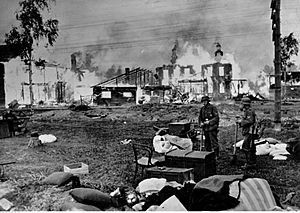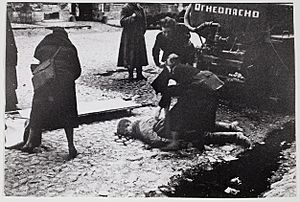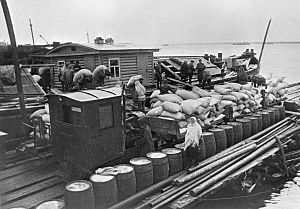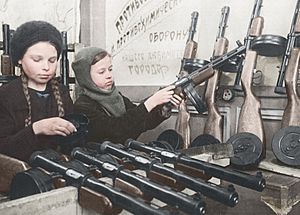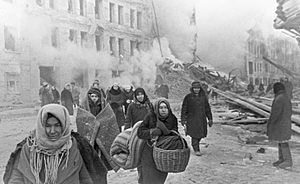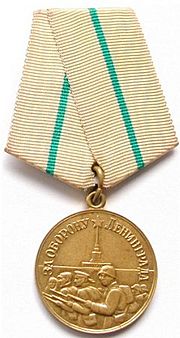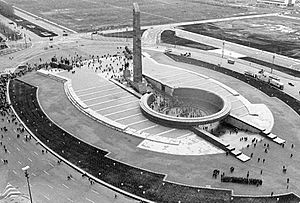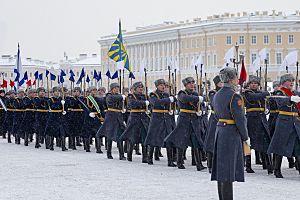Siege of Leningrad facts for kids
The Siege of Leningrad, also known as the Leningrad Blockade, was a long and terrible siege during World War II. It happened in the city of Leningrad (which is now called Saint Petersburg). The siege began on September 8, 1941, when the last road into the city was cut off.
Even though Soviet forces managed to open a small path to the city on January 18, 1943, the siege didn't fully end until January 27, 1944. This meant the blockade lasted for 872 days. It became one of the longest and most destructive sieges in history. Many people died, making it possibly the costliest siege in history. About 1.5 million people lost their lives because of the siege.
German forces stopped anyone or any supplies from entering or leaving the city. This left the people living there without food, sometimes for weeks or even months.
Contents
Why Was Leningrad Attacked?
Capturing Leningrad was one of the main goals for Germany in their plan called Operation Barbarossa. This plan was to invade the Soviet Union. Leningrad was very important for several reasons:
- It was the former capital of Russia.
- It was a symbol of the Russian Revolution.
- It was a major base for the Soviet Baltic Fleet.
- It had many factories, including ones that made weapons. In 1939, Leningrad produced 11% of all Soviet industrial goods.
Some stories say that Adolf Hitler was so sure he would capture Leningrad that he had invitations printed for victory parties. These parties were planned to happen at the city's Hotel Astoria.
Hitler's ultimate plan was to completely destroy Leningrad and its people. A message sent to the German army on September 29, 1941, said that after defeating the Soviet Union, there would be no reason for Leningrad to exist. It also said that if the city asked to surrender, the request should be denied. This was because the Germans did not want to feed or move the people. Hitler wanted to flatten Leningrad and give the land north of the River Neva to the Finns.
How Leningrad Prepared for Defense
The Soviet forces defending Leningrad were called the Leningrad Front. Marshal Kliment Voroshilov was in charge. They set up defenses around the city. These included different armies and naval forces.
Protecting Civilians: Evacuation Efforts
Many people were evacuated from Leningrad during the siege. Marshal Zhukov reported that out of 3.1 million people in Leningrad and its suburbs, about 1.7 million, including 414,148 children, were moved to safer areas. These areas included the Volga region, the Urals, Siberia, and Kazakhstan. This happened between June 1941 and March 1943.
By September 1941, Leningrad was cut off. Different Soviet armies held defensive positions around the city. The 8th Army helped keep a supply route open to the city. This route worked with the Ladoga Flotilla, which was a group of boats. Airplanes from the Leningrad military district PVO Corps and Baltic Fleet helped protect the city from the sky.
The defense of the city and the evacuation of civilians were managed by leaders like Andrei Zhdanov and Kliment Voroshilov. Naval forces, especially the Ladoga Flotilla, played a big role in helping people escape.
Bombing and Shelling Attacks
German forces surrounded Leningrad by September 8, 1941. They cut off all ways to get supplies into the city. Since they couldn't capture the city quickly, the Axis armies began a siege that lasted for "900 days and nights."
A very bad air attack happened on September 19. It was the worst air raid Leningrad faced during the war. 276 German bombers hit the city, killing 1,000 civilians. Many of those killed were recovering in hospitals that were bombed. Six air raids happened that day. Several hospitals and the city's largest shopping area were damaged. Hundreds of people had gone into the store to hide from the bombs.
German artillery also started shelling Leningrad in August 1941. The attacks became stronger in 1942 and even more intense in 1943. The Soviet Baltic Fleet's air force flew over 100,000 missions to support their operations. German shelling and bombing killed 5,723 civilians and wounded 20,507 in Leningrad during the siege.
Supplying the City: The Road of Life
To keep the city fighting, the Red Army needed a way to bring in supplies. This route became known as the Road of Life (Russian: Дорога жизни). It went across the southern part of Lake Ladoga. It also used a narrow strip of land not controlled by German forces.
During warmer months, boats carried supplies across Lake Ladoga. In winter, when the lake froze, vehicles drove over the thick ice. This part of the route was called "The Ice Road." The Ladoga Flotilla and other troops protected this supply line. Food was brought to a village called Osinovets. From there, it was moved about 45 kilometers (28 miles) by a small railway into Leningrad.
The Road of Life was also used to evacuate civilians. Before this road opened, the city was completely cut off. Vehicles on the ice road risked getting stuck in snow or falling through ice broken by German bombs. But this road brought in vital military and food supplies. It also took out civilians and wounded soldiers. This allowed the city to keep fighting the enemy.
How the Siege Affected Leningrad
The two-and-a-half-year siege caused huge destruction and the greatest loss of life ever seen in a modern city. Hitler had ordered the German army to loot and destroy many imperial palaces outside the city. These included the Catherine Palace and Peterhof Palace. Many art collections were taken to Germany. Factories, schools, hospitals, and other buildings were destroyed by air raids and artillery.
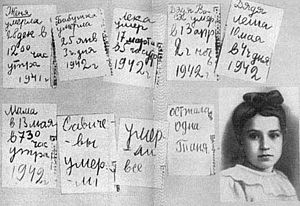
The 872 days of the siege caused extreme hunger in Leningrad. Utilities, water, energy, and food supplies were cut off. This led to the deaths of up to 1.5 million soldiers and civilians. Another 1.4 million people, mostly women and children, were evacuated. Many of them died during the evacuation due to hunger and bombing. The Piskaryovskoye Memorial Cemetery in Leningrad holds half a million civilian victims of the siege.
The economic damage and human losses in Leningrad were greater than in the Battle of Stalingrad or the Battle of Moscow. The Siege of Leningrad is known as the most lethal siege in world history. Some historians even call it a "racially motivated starvation policy." This was part of Germany's plan to wipe out populations in the Soviet Union.
People in the city suffered from extreme starvation, especially in the winter of 1941–42. From November 1941 to February 1942, citizens received only 125 grams (about 4.4 ounces) of bread per day. Half or more of this bread was made of sawdust and other things that were not food. In very cold temperatures (down to -30°C or -22°F), and with no city transport, even walking a few kilometers to get food was impossible for many. Deaths were highest in January–February 1942, with 100,000 people dying each month, mostly from starvation. People often died on the streets, and citizens became used to seeing death.
Soviet Efforts to Break the Siege
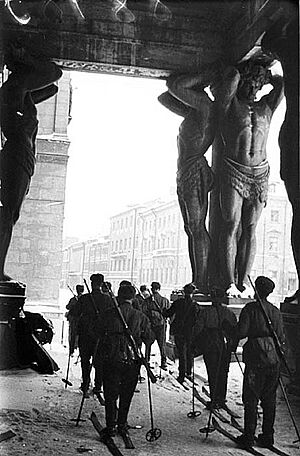
On August 9, 1942, the Symphony No. 7 "Leningrad" by Dmitri Shostakovich was performed in the city. The concert was played over loudspeakers throughout the city and even aimed towards the enemy lines. This was the same day Hitler had planned to celebrate the city's fall with a big dinner at Leningrad's Astoria Hotel.
The Sinyavino Offensive (1942)
The Sinyavino Offensive was a Soviet attempt to break the blockade in the autumn of 1942. The Soviet armies tried to connect with the forces of the Leningrad Front. At the same time, the Germans were planning their own attack to capture the city, called Operation Nordlicht. Neither side knew what the other was planning until the battle began.
The Soviet attack started on August 27, 1942. This forced the Germans to use their troops for defense instead of their planned attack. The battle also saw the first use of the Tiger tank, but it wasn't very successful. The Soviet attack eventually stopped, but the German forces also had to give up their offensive.
Operation Iskra (Spark)
The siege was finally broken during Operation Iskra (Spark). This was a large attack by the Leningrad and Volkhov Fronts. It began on the morning of January 12, 1943. After fierce fighting, the Red Army broke through strong German defenses south of Lake Ladoga. On January 18, 1943, Soviet troops met, opening a 10-12 kilometer (6-7.5 mile) wide land corridor. This provided some relief to the people in Leningrad.
The Spanish Blue Division faced a major Soviet attempt to break the siege in February 1943. The Soviet 55th Army, stronger after their victory at Stalingrad, attacked Spanish positions. Despite heavy losses, the Spanish soldiers held their ground against a much larger Soviet force. The Soviet attack was stopped.
Ending the Siege
The siege continued until January 27, 1944. On this day, the Soviet Leningrad–Novgorod Offensive pushed German forces away from the city's southern outskirts. This was a combined effort by several Soviet fronts and the Baltic Fleet. In the summer of 1944, Finnish forces were also pushed back.
The siege was also known as the Leningrad Blockade and the 900-Day Siege.
Timeline of Key Events
This timeline shows important events during the siege.
1941
- April: Hitler plans to occupy and destroy Leningrad as part of his Operation Barbarossa and Generalplan Ost plans.
- June 22: The Axis powers invade the Soviet Union with Operation Barbarossa.
- June 29: Construction of defenses begins south of Leningrad. Children and women start to be evacuated.
- June–July: Over 300,000 civilians from other areas come to Leningrad for safety. Soviet armies gather at the front lines. About 2 million soldiers are involved in the battle.
- July 19–23: The first German attack on Leningrad is stopped 100 kilometers (62 miles) south of the city.
- July 27: Hitler visits the German army group, angry about delays. He orders them to take Leningrad by December.
- August 20 – September 8: German artillery bombs Leningrad, hitting factories, schools, hospitals, and homes.
- August 21: Hitler orders the "Encirclement of Leningrad in conjunction with the Finns."
- August 20–27: Evacuation of civilians is blocked by attacks on railways and other exits.
- September 8: German forces reach Lake Ladoga, completing the land encirclement of Leningrad.
- September 10: Joseph Stalin appoints General Zhukov to lead the Leningrad Front and Baltic Fleet.
- September 12: The largest food storage building in Leningrad, the Badajevski General Store, is destroyed by a German bomb.
- September 19: German troops are stopped 10 kilometers (6 miles) from Leningrad. Citizens join the fight on the defense line.
- September 22: Hitler declares that "Saint Petersburg must be erased from the face of the Earth." He also says, "...we have no interest in saving lives of the civilian population."
- November 8: Hitler states in a speech: "Leningrad must die of starvation."
- December 6: The United Kingdom declares war on Finland.
- December 30: A Soviet counter-attack forces Germans to retreat from Tikhvin, stopping them from joining Finnish forces.
1942
- January: Soviets launch a battle for the Nevsky Pyatachok bridgehead to try and break the siege. This battle lasts until May 1943 and causes many casualties on both sides.
- April 4–30: German air force operation to sink Baltic Fleet ships fails.
- June–September: New German railway artillery bombs Leningrad with very heavy shells.
- August: The Spanish Blue Division is moved to Leningrad.
- August 9: The Symphony No. 7 "Leningrad" by Dmitri Shostakovich is performed in the city.
- August 19: Soviets begin the Sinyavino Offensive, which fails to lift the siege but stops German attack plans.
1943
- January–December: Artillery bombardments of Leningrad increase.
- January 12–30: Operation Iskra breaks through the siege. It opens a land corridor along Lake Ladoga into the city. The blockade is broken.
- February 10 – April 1: An unsuccessful operation tries to lift the siege completely.
1944
- January 14 – March 1: Several Soviet attacks begin, aiming to end the siege.
- January 27: The Siege of Leningrad officially ends. German forces are pushed 60–100 kilometers (37–62 miles) away from the city.
- January: Before retreating, German armies loot and destroy historical palaces like the Catherine Palace and Peterhof Palace. Many valuable art collections are taken to Germany.
During the siege, about 3,200 residential buildings and 9,000 wooden houses were burned. 840 factories and plants were destroyed in Leningrad and its suburbs.
Remembering the Siege
Leningrad Siege and Defence Museum
Even during the siege, war items were collected and shown to the public. For example, a German airplane that was shot down was displayed. These items showed the courage of the people. They were gathered in a special building and became the State Memorial Museum of the Defence and Siege of Leningrad .
After World War II, the museum faced problems. Many valuable exhibits were destroyed. The museum was later revived in the late 1980s. New facts about the city's heroism and the hardships of the time were shared. The museum is now in its original building, but it is not as large as it used to be.
Monuments: The Green Belt of Glory
Remembering the siege became very important again in the 1960s. Local artists created works dedicated to the victory. A poet named Mikhail Dudin suggested building a ring of monuments where the heaviest fighting happened. These monuments would be linked by gardens around the city. This became known as the Green Belt of Glory (Зелёный пояс Славы).
On October 29, 1966, a monument called Broken Ring was put up on the shore of Lake Ladoga. It pays tribute to the lives saved by the frozen Ladoga and the many lives lost.
The Monument to the Heroic Defenders of Leningrad on Victory Square was built on May 9, 1975, in Victory Square, Saint Petersburg.
This monument is a huge bronze ring with a gap in it. The gap points to where the Soviets finally broke through the German forces. In the center, a Russian mother holds her dying soldier son. The monument has an inscription that says "900 days 900 nights." An exhibit underneath the monument shows items from that time, like journals.
Memorial Cemeteries
During the siege, so many civilians and soldiers died that many burial places grew very large. The most famous of these is the Piskaryovskoye Memorial Cemetery.
Military Parade on Palace Square
Every year on January 27, a military parade takes place on Palace Square to celebrate the lifting of the siege. About 3,000 soldiers and cadets take part. The parade includes people dressed in Red Army uniforms from the war. It also features wartime tanks like the T-34 and flags from the war. Military bands provide music for the parade.
Related pages
Images for kids
-
Hitler with Finland's Marshal Carl Gustav Mannerheim.
See also
 In Spanish: Sitio de Leningrado para niños
In Spanish: Sitio de Leningrado para niños


